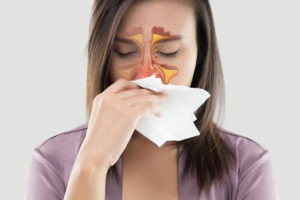
Conditions that can cause sinus blockage include the common cold, allergic rhinitis (swelling of the lining of the nose), nasal polyps (small growths in the lining of the nose), or a deviated septum (a shift in the nasal cavity).
There are different types of sinusitis, including:
- Acute sinusitis: A sudden onset of cold-like symptoms such as runny, stuffy nose and facial pain that does not go away after 10 to 14 days. Acute sinusitis typically lasts 4 weeks or less.
- Sub acute sinusitis: An inflammation lasting 4 to 8 weeks.
- Chronic sinusitis: A condition characterized by sinus inflammation symptoms lasting 8 weeks or longer.
- Recurrent sinusitis: Several attacks within a year.
Sinusitis can be classified by the sinus cavity which it affects:
- Maxillary – can cause pain or pressure in the maxillary (cheek) area (e.g., toothache or headache)
- Frontal – can cause pain or pressure in the frontal sinus cavity (located above eyes), headache, particularly in the forehead
- Ethmoidal – can cause pain or pressure pain between/behind the eyes, the sides of the upper part of the nose (the medial canthi), and headaches
- Sphenoidal – can cause pain or pressure behind the eyes, but often refers to the skull vertex (top of the head), over the mastoid processes, or the occiput (back of the head)
Sinusitis is caused by too much mucus, or a swelling of the lining of the sinuses and nose, which can block the narrow channels. This can occur during a cold, or may be due to allergy or irritation of the linings of the sinuses. Bacteria (germs) then grow inside the sinuses, causing pain, headache and sometimes fever. Mucus from infected sinuses can be yellow or green. Some people get sinusitis with most colds, while others get it rarely.
Sinusitis symptoms, whether acute or chronic, frequently develop after a cold or during times of severe or ongoing allergic rhinitis symptoms. The most obvious sign of sinusitis is a painful pressure in the cheeks and forehead. Other symptoms include:
- Thick yellow-green nasal discharge
- Postnasal drip, often with a bad taste
- Cough
- Headache
- Swelling of the face
- Loss of the senses of smell and taste
- Blocked nose
- Feeling of pressure inside the face
- Facial pain, particularly when leaning forward
- Congestion
- Toothache
- Generally feeling unwell
In cases of acute sinusitis, a fever may develop.
An X-ray of the para nasal sinuses is often the first test done. Haziness or opacities in the region of the infected sinus is often seen.
Other diagnostic tests to assess the potential causes for sinusitis may include a mucus culture, nasal endoscopy, allergy testing, CT scan of the sinuses, or blood work.
Fungal scrapings and smears may be taken from the discharge and fungal cultures have to be done if a fungal aetiology is suspected.
Ayurveda Management

The Ayurvedic approach to sinusitis treatment is multifaceted and can involve a combination detoxification processes through Panchakarma, oral medicines, dietary and life style modifications.
Therapies like Nasyam, Lepanam, Thalam, Vamanam, Shirodhara are commonly practiced depending on the dosha predominance and severity.
Nasya Karma or Nasyam is a unique and one of the five detoxification therapies mentioned in Ayurveda, highly successful in treating Sinusitis. It is a process in which medicated oil or powder or fresh juice is administered through the nostrils to clear the Kapha accumulated. Recurrence can also be prevented.
Average duration of therapy is around 7 days. Oral medicines duration will be around 6 - 12 months depending on recovery.

